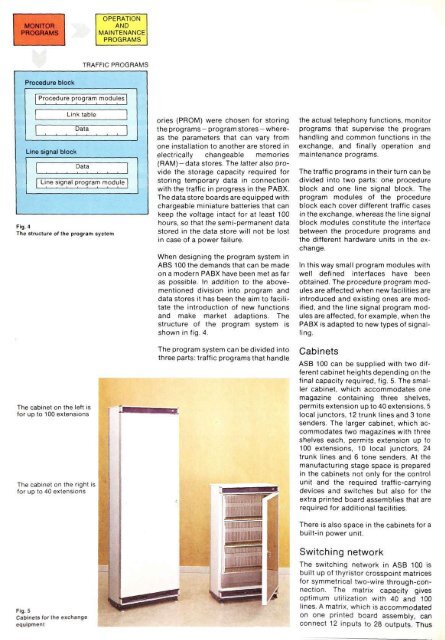ericsson review - ericssonhistory.com
ericsson review - ericssonhistory.com
ericsson review - ericssonhistory.com
You also want an ePaper? Increase the reach of your titles
YUMPU automatically turns print PDFs into web optimized ePapers that Google loves.
Fig. 4<br />
The structure of the program system<br />
The cabinet on the left is<br />
for up to 100 extensions<br />
The cabinet on the right is<br />
for up to 40 extensions<br />
Fig. 5<br />
Cabinets for the exchange<br />
equipment<br />
ories (PROM) were chosen for storing<br />
the programs — program stores - whereas<br />
the parameters that can vary from<br />
one installation to another are stored in<br />
electrically changeable memories<br />
(RAM)-data stores. The latter also provide<br />
the storage capacity required for<br />
storing temporary data in connection<br />
with the traffic in progress in the PABX.<br />
The data store boards are equipped with<br />
chargeable miniature batteries that can<br />
keep the voltage intact for at least 100<br />
hours, so that the semi-permanent data<br />
stored in the data store will not be lost<br />
in case of a power failure.<br />
When designing the program system in<br />
ABS 100 the demands that can be made<br />
on a modern PABX have been met as far<br />
as possible. In addition to the abovementioned<br />
division into program and<br />
data stores it has been the aim to facilitate<br />
the introduction of new functions<br />
and make market adaptions. The<br />
structure of the program system is<br />
shown in fig. 4.<br />
The program system can be divided into<br />
three parts: traffic programs that handle<br />
the actual telephony functions, monitor<br />
programs that supervise the program<br />
handling and <strong>com</strong>mon functions in the<br />
exchange, and finally operation and<br />
maintenance programs.<br />
The traffic programs in their turn can be<br />
divided into two parts: one procedure<br />
block and one line signal block. The<br />
program modules of the procedure<br />
block each cover different traffic cases<br />
in the exchange, whereas the line signal<br />
block modules constitute the interface<br />
between the procedure programs and<br />
the different hardware units in the exchange.<br />
In this way small program modules with<br />
well defined interfaces have been<br />
obtained. The procedure program modules<br />
are affected when new facilities are<br />
introduced and existing ones are modified,<br />
and the line signal program modules<br />
are affected, for example, when the<br />
PABX is adapted to new types of signalling.<br />
Cabinets<br />
ASB 100 can be supplied with two different<br />
cabinet heights depending on the<br />
final capacity required, fig. 5. The smaller<br />
cabinet, which ac<strong>com</strong>modates one<br />
magazine containing three shelves,<br />
permits extension up to 40 extensions, 5<br />
local junctors, 12 trunk lines and 3 tone<br />
senders. The larger cabinet, which ac<strong>com</strong>modates<br />
two magazines with three<br />
shelves each, permits extension up to<br />
100 extensions, 10 local junctors, 24<br />
trunk lines and 6 tone senders. At the<br />
manufacturing stage space is prepared<br />
in the cabinets not only for the control<br />
unit and the required traffic-carrying<br />
devices and switches but also for the<br />
extra printed board assemblies that are<br />
required for additional facilities.<br />
There is also space in the cabinets for a<br />
built-in power unit.<br />
Switching network<br />
The switching network in ASB 100 is<br />
built up of thyristor crosspoint matrices<br />
for symmetrical two-wire through-connection.<br />
The matrix capacity gives<br />
optimum utilization with 40 and 100<br />
lines. A matrix, which is ac<strong>com</strong>modated<br />
on one printed board assembly, can<br />
connect 12 inputs to 28 outputs. Thus
















